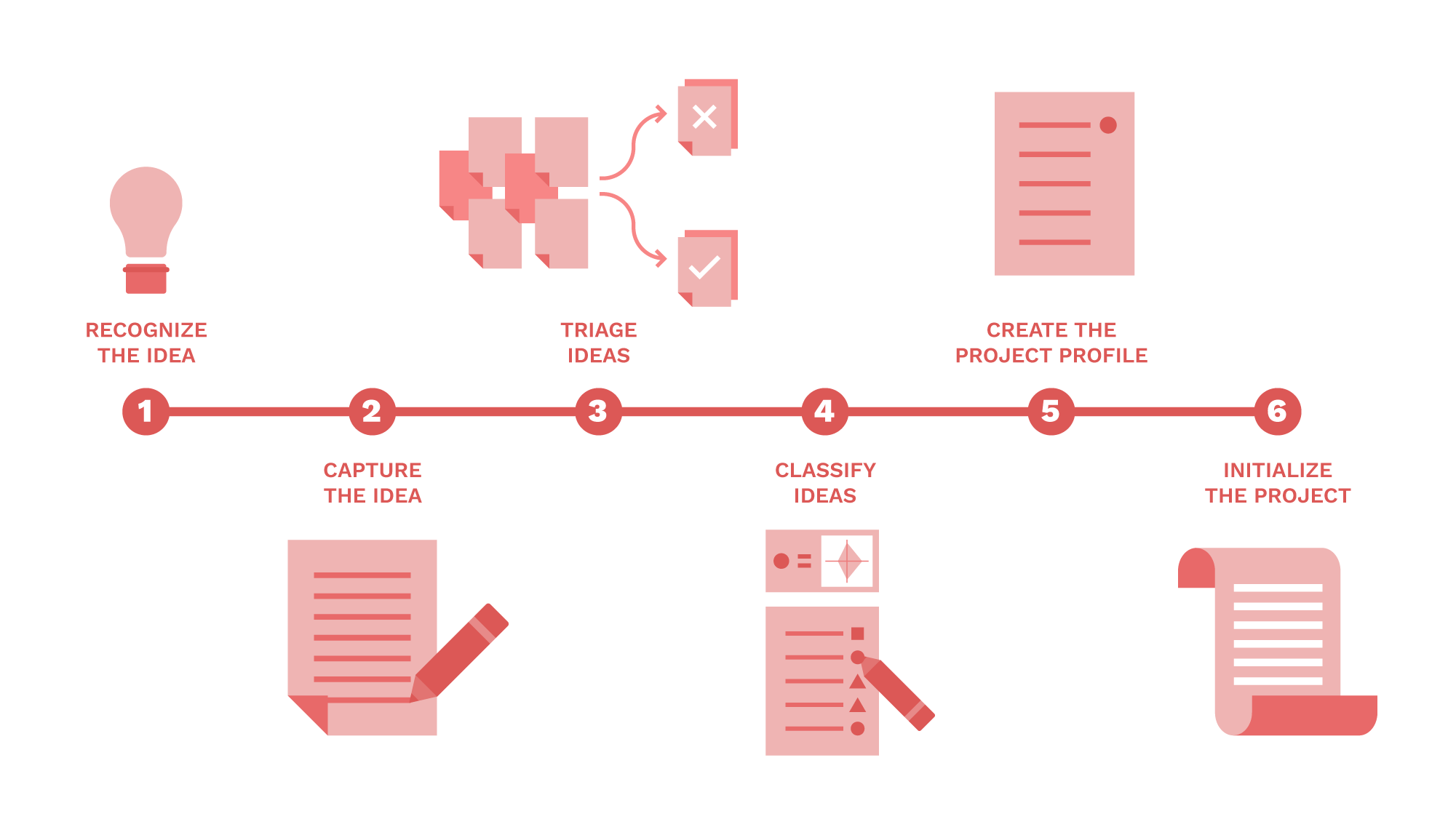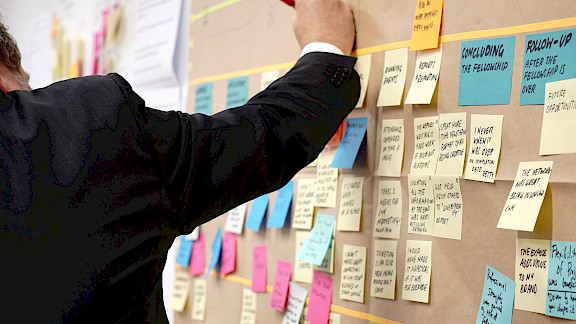Project management | Methodology
How a project is born: from an idea to a project profile
"How did it actually come about that we are doing this project in our organization? I invest a lot of time in it as an employee, I just happened to be on the project team, and I don't even know how it started." Does this sound familiar in any way? Who decides what projects we do? How do projects even get started in an organization?
Authors : Dr. Daniel Hösli, Bruno Jenny | Last updated: 03. Jul 2023 | 6 minutes read

Once upon a time, there was an idea...
Yes, how does a project actually begin? Often it starts when someone in the team makes a suggestion about what could be done better in the organization. Just like that, maybe not even in a meeting, but quite banally during a coffee break. And suddenly one or the other jumps up, and a spontaneous idea turns into momentum. Someone goes to the boss and carries the idea forward. Sometimes some people start with preliminary work, sketch proposals for solutions, ask others for their opinion, and, and, and... And suddenly there is something like a project going on, but nobody calls it that and it is certainly not official. But the idea would be good, and there would be a lot of drive. But what is missing?
What makes an idea a project
Perhaps we should ask ourselves the question: What is a project anyway? In many organizations, what is supposedly clear is not so clear after all. Of course, everyone has an idea of what is meant by a project. What is missing, however, is a clear definition in the organization of what "we here in the company" understand as a project, crisp criteria that a project must fulfill in order to be considered a project. A definition in the narrower sense - not as loose as perhaps in an explanatory dictionary. Rather, what is described in a project management reference book. It would say, for example, that a project should have goals and be approved by a client. And what about the idea above? Did you set clear, measurable goals and were you given time to work on the project to achieve those goals? Probably not. It just started. And that's where we'd like to hook in with this article.
Capturing ideas...
Basically, it's great when employees come up with ideas for the company. These own initiatives are positive and a sign that people are thinking for themselves. What's important is that there are contact points and receptacles where ideas can be fed in in exactly the same way as strategic initiatives, so that someone catches them and assesses and processes them in a targeted manner. This does not mean that this office should immediately begin to implement the ideas. Rather, all ideas should flow into a funnel and be evaluated according to various aspects. To do this, the ideas should first be put into a form to make them comparable to a certain degree. The idea should be cast into a simple form. What is the purpose of the idea? What kind of problem does it solve? What is the goal of it? How many or what people would need to agree or participate for this to happen? Do we need money for it? Only if such questions are answered, the idea gets a face and can be processed systematically.
Of course, there are also idea generation processes that are specifically designed to generate new ideas or "tickle" them out of employees. That is not what we are talking about here. First of all, it is only about capturing existing ideas and moving them forward in an orderly manner.
...and systematically transfer to the project profile (or not)
There are ideas that don't survive for long, let alone make it into a project. Many ideas quickly turn out to be "not feasible", "hot air" or "not fundable". In the first phase, after an idea has been captured and systematically formulated, it must now assert itself in the group of other ideas. Once the wheat has been separated from the chaff, many ideas remain that would in principle be worth implementing. So why don't we just do it all? Simple answer: for resource reasons. The implementation of any idea costs money - be it effort that has to be put in, money that has to be spent or time until the implementation is completed. The purpose of this first phase in the life cycle of a project (we already call it that here, but actually it's not one yet) is to systematically and uniformly record the really interesting ideas, i.e. to document them by means of a profile.
In this phase (also called the "kneading phase"), an evaluation of the potential is also required. What is the product vision? What benefit or added value does the implementation of the idea bring us and/or the customer? And what is the relationship between the benefit and the implementation and opportunity costs? How does the idea relate to the corporate strategy? Does it align well with a strategic initiative, for example? Such questions should be approached systematically. All ideas are to be evaluated against the same questions and thus classified. This step of classification is to be done by an institutionalized body such as the PMO. This results in the qualified project profiles. They are maintained in a pool and form the basis for the selection of future projects.
It is now up to a qualified PMO and the project portfolio committee, which has a suitable tool, to record the new project ideas, compare them with the current projects, list the rough costs and resources, and create appropriate implementation scenarios with the help of simulation functions. The aim is to reach a quick and qualified initial decision.
Project profiles are therefore standardised project proposals that are developed into project contracts during the initialisation phase. This phase is often also called the pre-project or, as already mentioned, the "kneading phase". It involves more precise preliminary clarifications in order to better estimate the relevant key performance indicators such as project duration and costs as well as personnel expenditure. Or in which form the idea should ideally be implemented: Agile, hybrid or conventional? The details of such a project initialization would go beyond the scope of this article.

Conclusion
An idea is far from being a project. Only by systematically recording, formulating and classifying ideas do project profiles emerge that can be compared with each other. Project profiles are nothing more than project proposals and form the basis for preliminary projects. In view of the limited resources available, those projects that best fit the strategic goals of the company are to be developed into project orders.
Experience how you can capture an idea in PQFORCE with just a few clicks, evaluate it and turn it into a project proposal using Lifecycle.
On the knowledge and action platform profi.pm® 4.0 for efficient and agile project management by Bruno Jenny you will find helpful templates.
About the authors
Dr. Daniel Hösli is Managing Director and Lead Consultant at INTRASOFT AG, whose SaaS solution PQFORCE is the leading platform for agile, project-oriented business management. He has been involved in the development of project management systems on a daily basis for 15 years in a consulting and project management capacity - both organizationally and technically - and thus has the experience from countless contacts and tasks from a wide variety of companies and different management levels.
Bruno Jenny is the owner of SPOL AG. For more than 35 years, he has been implementing and supporting projects for internationally active insurance, banking and industrial groups as well as public administrations. In his function as external quality and risk manager, he is involved in renowned large-scale projects. Furthermore, he establishes strategic project portfolios together with his clients. As a renowned author of specialist books, lecturer, coach and examination expert, he is an extremely well-versed expert on the training scene and has been lecturing at various schools and companies since 1988.
The companies INTRASOFT AG and SPOL AG maintain a cooperative, synergetic relationship. Our customers benefit from the digital, best-practice oriented platform PQFORCE and the wealth of experience and practice-oriented consulting approach of SPOL AG.










